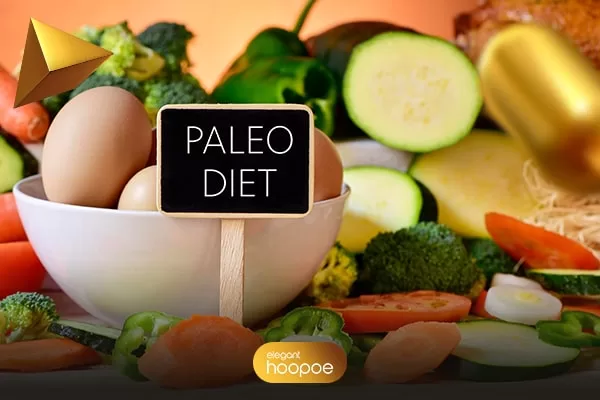Can the Paleo Diet Help You Lose Weight?
Yes, the Paleo diet can aid in weight loss by focusing on whole, unprocessed foods while eliminating processed items, grains, dairy, and refined sugars. Here’s why it works:
Lower calorie intake: Eliminating processed foods naturally reduces overall calorie consumption.
Higher protein intake: Lean meats and seafood boost satiety, helping control appetite.
Reduced carbohydrates: Cutting out grains and sugars stabilizes blood sugar and promotes fat burning.
More fiber: Non-starchy vegetables and fruits enhance digestion and keep you full longer.
However, weight loss isn’t guaranteed, as results depend on individual factors like calorie intake, activity level, and adherence to the diet.
The Paleo Diet is one of the best diets for weight loss and a popular dietary approach, that emphasizes eating whole, unprocessed foods. Our ancestors commonly consumed these foods during the Paleolithic era, before the advent of agriculture. The diet is also known as Paleolithic Diet or Caveman Diet.
We all know that the modern diet is often high in processed foods, refined sugars, and grains, and can lead to various health problems. The core idea behind the paleo diet is that our bodies are better adapted to the foods our ancient ancestors ate.
According to Proponents of the Paleolithic Diet views, it can help to lose weight, improve digestion, reduce inflammation, and lower the risk of chronic diseases such as diabetes, heart disease, and cancer. While the diet has its critics, it has gained a significant following in recent years and has become a popular way of eating for many people.
What is the Paleo Diet?
The Paleo Diet or Paleolithic Diet is a dietary approach that has gained popularity in recent years as a way of eating that may help with weight loss. It emphasizes eating whole, unprocessed foods that were commonly consumed by our Paleolithic ancestors, such as meat, fish, vegetables, fruits, nuts, and seeds.
The theory behind the diet is that our bodies are better adapted to the foods our ancestors ate during the Paleolithic era, before the advent of agriculture. Also, modern processed foods, refined sugars, and grains can lead to various health problems.
The Paleolithic Diet eliminates processed foods, grains, dairy, legumes, and refined sugars, and instead focuses on nutrient-dense foods that are believed to promote optimal health.
How Does the Paleo Diet Work?
As we said, the Paleo Diet emphasizes the consumption of whole, unprocessed foods that were commonly consumed by our Paleolithic ancestors. Modern processed foods, grains, dairy, legumes, and refined sugars are eliminated.
Proponents of the Paleo Diet believe that by eating a diet rich in nutrient-dense whole foods, the body is better able to regulate blood sugar levels, reduce inflammation, and support optimal health. This is in contrast to modern diets that are often high in processed foods and refined sugars which can lead to overconsumption, weight gain, and a host of chronic health problems.
The Paleo Diet eliminates grains and legumes based on the theory that these foods contain anti-nutrients and may contribute to digestive issues and inflammation in some individuals. Dairy elimination is based on the idea that many people are lactose intolerant or sensitive to dairy proteins.
Despite the popularity of the Paleolithic Diet in recent years, it is not without criticism. Some experts argue that the diet is overly restrictive. It eliminates important food groups that provide important nutrients. Others suggest that the evolutionary theory behind the diet is flawed. Our Paleolithic ancestors had diverse diets that vary according to region and period.
The Evolutionary Theory Behind the Paleo Diet
Our Paleolithic ancestors had a diet that was more in line with our genetic makeup than the modern Western diet and this is the evolutionary theory behind the Paleo Diet. The Paleolithic era lasted from about 2.6 million years ago to around 10,000 BCE. During this time, humans were hunter-gatherers who subsisted on a diet of meat, fish, vegetables, fruits, nuts, and seeds.
Proponents of the Paleolithic Diet argue that our bodies are better adapted to the types of foods that were available during the Paleolithic era. They believe that modern processed foods, grains, dairy, and refined sugars are relatively recent additions to the human diet that may contribute to various health problems.
Several observations about human physiology and the diets of our Paleolithic ancestors are bases of The Paleo Diet. According to proponents of diet, our bodies are better adapted to the types of fats found in animal products and nuts. Meanwhile, a high intake of grains and refined sugars can lead to chronic health problems such as obesity, type 2 diabetes, heart disease, and more.
Although some experts criticized the evolutionary theory behind the Paleolithic Diet, many people have reported success in achieving weight loss and improved health by following the diet. We note here that the diet is not intended to be a strict historical reenactment of the Paleolithic era, but rather a dietary approach that emphasizes whole, unprocessed foods.

Benefits of the Paleolithic Diet
- Weight loss: The Paleo Diet emphasizes whole, unprocessed foods and eliminates processed foods, grains, dairy, legumes, and refined sugars, which may help to promote weight loss.
- Improved blood sugar control: By eliminating refined sugars and processed foods, the Paleo Diet may help to improve blood sugar control and reduce the risk of developing type 2 diabetes.
- Reduced inflammation: The Paleolithic Diet emphasizes whole, nutrient-dense foods that are rich in anti-inflammatory compounds, which may help to reduce inflammation in the body.
- Improved digestive health: By eliminating processed foods, grains, and legumes, the Paleolithic Diet may help to improve digestive health and reduce the risk of digestive issues such as bloating, gas, and constipation.
- Improved nutrient intake: The Paleo Diet emphasizes whole, nutrient-dense foods such as fruits, vegetables, and lean proteins, which may help to improve overall nutrient intake and reduce the risk of nutrient deficiencies.
Potential side effects of the Paleolithic Diet
- Nutrient deficiencies
Eliminating food groups like dairy and grains can lead to a lack of important nutrients such as calcium and vitamin D, which are essential for bone health.
The solution: Ensure that you’re getting enough of these nutrients through other sources, such as leafy greens and fatty fish.
- Digestive issues
The high amount of meat and low amount of fiber in the Paleo Diet can lead to digestive problems such as constipation, bloating, and gas.
The solution: Incorporate plenty of non-starchy vegetables and fruits to promote healthy digestion.
- Increased saturated fat intake
While the Paleo Diet emphasizes healthy fats, such as those from nuts, seeds, and avocados, it can also lead to an increased intake of saturated fats from animal products like meat and butter. Too much-saturated fat can increase the risk of heart disease.
- Difficulty with social situations
Following the Paleo Diet can make it challenging to eat out at restaurants or attend social events where food is being served, which can lead to feelings of isolation and restriction.
- Higher cost
The Paleo Diet often involves purchasing higher quality, organic meats and produce, which can be more expensive than conventionally grown foods.
Note: Before starting the Paleolithic Diet, speak with a healthcare provider to ensure that it is a safe and appropriate dietary approach for you. It also ensures that you are meeting your nutritional needs while avoiding any potential negative side effects.
Foods to Eat on the Paleo Diet
Some foods that are typically allowed on the Paleo Diet include:
- Meat: Beef, pork, lamb, and other types of meat, as long as animals are grass-fed and free of antibiotics and hormones.
- Poultry: Chicken, turkey, and other types of poultry, as long as they are free-range and organic.
- Fish and Seafood: These foods are rich in omega-3 fatty acids and are an important part of the Paleo Diet (Wild-caught fish and seafood are preferred over farmed varieties).
- Vegetables: Non-starchy vegetables such as leafy greens, broccoli, cauliflower, carrots, peppers, and onions
- Fruits: such as berries, apples, pears, and oranges in moderation.
- Nuts and Seeds: such as almonds, cashews, walnuts, and pumpkin seeds, as long as they are raw or roasted without added oils.
- Healthy Fats: such as olive oil, coconut oil, and avocado oil, but in moderation.
- Spices and Herbs: such as garlic, ginger, turmeric, and oregano can add flavor to meals.

Foods to Avoid on the Paleo Diet
Some foods that you cannot eat on the paleo diet, include:
- Grains: All grains such as wheat, rice, oats, and corn
- Dairy: All dairy products such as milk, cheese, yogurt, and butter
- Legumes: All legumes such as beans, lentils, and peanuts
- Processed Foods: All processed foods such as packaged snacks, chips, and other convenience foods
- Refined Sugars: All refined sugars such as white sugar, corn syrup, and high-fructose corn syrup
- Vegetable Oils: Vegetable oils such as canola oil, soybean oil, and corn oil
- Alcohol: Although some versions of the diet allow for moderate consumption of certain types of alcohol, such as red wine.
Note: While the Paleolithic Diet does allow for a variety of foods, entire food groups such as grains, dairy, and legumes were eliminated from it. Thus, some people may make it challenging to meet their nutritional needs. We recommend you speak with a healthcare provider before starting the Paleo Diet. It ensures that the Diet is a safe and appropriate dietary approach for you.
Sample one-day meal plan for the Paleo Diet
Breakfast:
- Scrambled eggs cooked in coconut oil with spinach, onions, and mushrooms
- Sliced avocado on the side
- Black coffee or herbal tea
Morning Snack:
- Apple slices with almond butter
Lunch:
- Grilled chicken breast with roasted sweet potatoes and green beans
- Mixed greens salad with olive oil and balsamic vinegar dressing
Evening Snack:
- Carrot sticks with guacamole
Dinner:
- Grilled salmon with asparagus and roasted Brussels sprouts
- Roasted butternut squash
Bed-Time Snacks:
- Baked apple slices topped with cinnamon and coconut cream
Sample one-week meal plan for the Paleo Diet
Monday:
- Breakfast: Scrambled eggs cooked in coconut oil with peppers, onions, and tomatoes + Sliced avocado
- Morning Snack: Almond butter and celery sticks.
- Lunch: Grilled chicken breast with roasted sweet potatoes and green beans. Mixed greens salad with olive oil and balsamic vinegar dressing.
- Evening Snack: Apple slices with almond butter.
- Dinner: Baked salmon with roasted asparagus and sautéed kale.
Tuesday:
- Breakfast: Sliced turkey breast with sautéed spinach and mushrooms
- Morning Snack: Carrot sticks with guacamole.
- Lunch: Turkey chili with diced tomatoes, onions, peppers, and spices.
- Evening Snack: Mixed nuts.
- Dinner: Grilled steak with roasted carrots and broccoli.
Wednesday:
- Breakfast: Sweet potato and egg scramble with sautéed kale + Sliced avocado
- Morning Snack: Sliced pear with almond butter.
- Lunch: Tuna salad with mixed greens, cucumber, and tomato. Olive oil and balsamic vinegar dressing.
- Evening Snack: Beef jerky.
- Dinner: Grilled chicken thighs with roasted Brussels sprouts and butternut squash.
Thursday:
- Breakfast: Smoked salmon with scrambled eggs and sliced tomato + sliced avocado
- Morning Snack: Coconut chips.
- Lunch: Grilled shrimp with zucchini noodles and cherry tomatoes. Olive oil and lemon juice dressing.
- Evening Snack: Banana slices with almond butter.
- Dinner: Slow-cooker beef stew with carrots, parsnips, and sweet potato.
Friday:
- Breakfast: Omelette with diced ham, peppers, onions, and spinach. Sliced avocado on the side.
- Morning Snack: Mixed berries.
- Lunch: Ground beef and broccoli stir-fried with garlic and ginger.
- Evening Snack: Roasted pumpkin seeds.
- Dinner: Grilled salmon with roasted sweet potatoes and green beans.
Saturday:
- Breakfast: Baked sweet potato with sliced banana and almond butter.
- Morning Snack: Hard-boiled egg.
- Lunch: Grilled chicken salad with mixed greens, cucumber, and tomato. Olive oil and balsamic vinegar dressing.
- Evening Snack: Sliced bell pepper with guacamole.
- Dinner: Grilled pork chops with roasted cauliflower and sautéed kale.
Sunday:
- Breakfast: Paleo pancakes made with almond flour and topped with fresh berries.
- Morning Snack: Beef jerky.
- Lunch: Turkey burger with lettuce wrap, sliced tomato, and avocado.
- Evening Snack: Mixed nuts.
- Dinner: Baked chicken with roasted sweet potatoes and green beans.
Who should avoid the Paleolithic Diet?
Certain groups should avoid it or use caution including:
- Individuals with pancreatitis or liver disease: The high-fat content of the diet can put stress on the pancreas and liver, potentially worsening conditions like pancreatitis or liver disease.
- Pregnant or breastfeeding women: Because it may not provide enough nutrients for fetal or infant development. The diet could also affect the milk supply.
- Individuals with gallbladder or pancreatic disease: The diet may increase the risk of developing gallstones, and can worsen symptoms of pancreatitis.
- People with a history of disordered eating: The strict rules of the ketogenic diet, which require careful tracking of macronutrients and limiting certain food groups, can be triggering for those with a history of disordered eating.
- Athletes engaging in high-intensity exercise: The ketogenic diet may not provide enough carbohydrates for high-intensity exercise, leading to decreased performance and recovery time.
Criticisms of the Paleo Diet
The Paleolithic Diet has been subject to criticism from various sources, including:
- There is a lack of scientific evidence and limited long-term research on the Paleo Diet’s effectiveness and safety.
- The Diet has restrictive nature because it eliminates entire food groups such as grains and legumes. Thus it is difficult to meet nutrient needs and may lead to dietary imbalances.
- Its emphasis on grass-fed meats, wild-caught seafood, and organic produce can make the Paleo Diet more expensive than other dietary approaches.
- The high consumption of animal products can have negative environmental consequences and impacts, including greenhouse gas emissions and deforestation.
- Critics argue that it may not accurately reflect the diets of our Paleolithic ancestors, as our ancestors likely had varied diets depending on location and resources.
Is the Paleolithic Diet Right for You?
Whether or not the Paleo Diet is right for you depends on various factors, including your health status, nutrient needs, lifestyle, and personal preferences.
The Paleo Diet may be beneficial for individuals who:
- Are looking to improve their overall health: The Diet emphasizes whole, nutrient-dense foods, which can provide numerous health benefits.
- Want to lose weight: The Diet has been associated with weight loss due to its emphasis on whole foods, increased protein intake, and reduced carbohydrate intake.
- Have food sensitivities or allergies: The Diet eliminates common allergens such as wheat, dairy, and soy, which may benefit individuals with food sensitivities or allergies.
- Are looking to reduce their intake of processed foods: The Diet eliminates processed and refined foods, which can be beneficial for overall health and well-being.
However, the Paleo Diet may not be appropriate or sustainable for everyone, including individuals who:
- Require a higher carbohydrate intake: The Paleo Diet eliminates grains, legumes, and starchy vegetables, which may not provide enough carbohydrates for individuals with high energy needs or specific health conditions.
- Have kidney disease: The high protein content of the Paleolithic Diet may put additional stress on the kidneys, potentially worsening kidney disease.
- Have difficulty affording or sourcing organic or grass-fed animal products: The emphasis on these products in the Paleo Diet can make it more expensive and difficult to follow.
- Are unable or unwilling to eliminate entire food groups: The restrictive nature of the Paleolithic Diet may not be sustainable or desirable for some individuals.
Note: Weigh the potential benefits and drawbacks of the Paleo Diet, and work with a healthcare provider or a dietitian to determine if the Paleo Diet is a safe and appropriate dietary approach for you.
Weight Loss and the Paleolithic Diet
The Paleo Diet has been associated with weight loss due to several factors:
- Lower calorie intake: Eliminating processed and high-calorie foods can lead to a lower overall calorie intake. This can create a calorie deficit and lead to weight loss.
- Increased protein intake: Consumption of lean meats and seafood, which are high in protein. Protein can increase satiety and reduce appetite, leading to lower calorie intake overall.
- Reduced carbohydrate intake: Eliminating grains, legumes, and refined sugars (sources of carbohydrates) can lead to a decrease in insulin levels and a shift towards fat-burning, potentially promoting weight loss.
- Increased fiber intake: Non-starchy vegetables and fruits (which are high in fiber) can promote satiety and reduce calorie intake.
Note: weight loss on the Paleo Diet is not guaranteed, because it depends on individual factors such as calorie intake, exercise habits, and overall health status. Additionally, it may not be sustainable long-term, as the restrictive nature of the diet can be difficult to maintain over time.

Tips for Following the Paleo Diet | Precautions Before Starting a Paleolithic Diet for weight loss
- Plan your meals: Before starting the diet, consider meal planning and grocery shopping to ensure that you have the necessary ingredients on hand. Ensure you access appropriate foods and don’t resort to less healthy options.
- Emphasize whole, nutrient-dense foods: Consume a variety of whole, nutrient-dense foods such as meats, fish, eggs, fruits, vegetables, and nuts.
- Eliminate processed and refined foods: Avoid processed and refined foods such as sugary snacks, soda, and fast food. These foods can be detrimental to health.
- Prioritize grass-fed, organic, and wild-caught options: If possible, choose grass-fed meats, organic produce, and wild-caught seafood for optimal nutrient content.
- Experiment with alternative flours: Since the Paleo Diet eliminates grains, alternative flours such as almond or coconut flour can provide options for baking.
- Be mindful of your carbohydrate intake: While the Paleo Diet reduces carbohydrate intake, ensure that you’re still consuming enough carbohydrates to meet your energy needs.
- Stay hydrated: Drinking enough water can help prevent constipation, a common side effect of the Paleo Diet.
- Consider supplements: Since the Paleo Diet eliminates grains and legumes, it may be necessary to supplement with certain nutrients such as fiber or calcium.
- Be mindful of the environmental impact: While the Paleo Diet can be beneficial for health, consider the environmental impact of consuming high amounts of animal products, and choose sustainable options when possible.
- Listen to your body: Everyone’s body is unique, listen to your body’s needs and adjust your diet as necessary to optimize your health and well-being. For example, if you find that certain foods do not agree with you or are not satisfying, you may need to make adjustments to your meal plan.
Concluding Remarks
To follow the Paleo Diet safely and effectively, focus on consuming a variety of whole, nutrient-dense foods and carefully monitor nutrient intake. Consulting with a healthcare professional or a dietitian can also help develop a personalized meal plan and ensure that the diet is appropriate for individual needs and goals. Consult with a healthcare professional is especially important if you have any underlying health conditions or are taking any medications that may be affected by changes in your diet.
Consider your individual nutrient needs, If you are pregnant or breastfeeding. You may need to consume more nutrients such as calcium and iron. By taking these precautions and being mindful of your individual needs and progress, you can ensure that the Paleo Diet is a safe and effective approach to weight loss for you.






